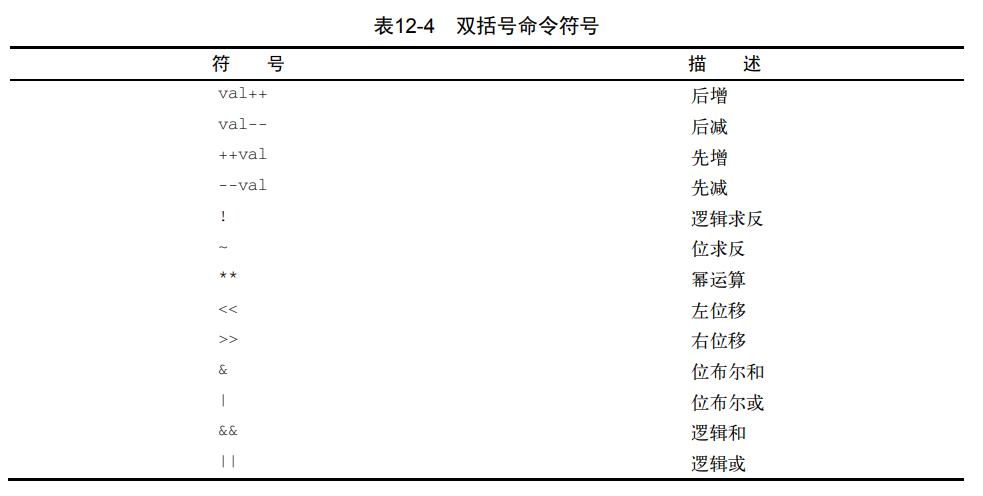Shell编程学习笔记
变量#
设置局部变量
变量名=变量值
设置全局变量
export 变量名=变量值
删除变量
unset 变量名
添加PATH环境变量
PATH=$PATH:[路径]
数组变量
mytest=(one two three four five)
echo $mytest
---> one
显示数组某个位置的变量
echo ${mytest[2]}
---> three
显示整个数组变量
echo ${mytest[*]}
---> one two three four five
命令替换#
有两种方法可以将命令输出赋给变量:
1、反引号字符(`)
2、$()格式(推荐)
#!/bin/sh
testing=$(date)
echo "The date and time are: " "$testing"
testing2=`date`
echo "The date and time are: " "$testing2"
重定向输入与输出#
输出重定向#
最基本的重定向将命令的输出发送到一个文件中。bash shell用大于号(>)来完成这项功能
command > outputfile
如果输出文件已经存在了,重定向操作符会用新的文件数据覆盖已有文件
输入重定向#
command < inputfile
数学运算#
使用 $((expression))
#!/bin/bash
var1=$((1+5))
echo ${var1}
只支持整数运算,浮点运算需要使用bc,待补充
退出脚本#
Linux提供了一个专门的变量$?来保存上个已执行命令的退出状态码。对于需要进行检查的 命令,必须在其运行完毕后立刻查看或使用$?变量。它的值会变成由shell所执行的最后一条命令 的退出状态码。
exit 命令#
默认情况下,shell脚本会以脚本中的最后一个命令的退出状态码退出。
可以改变这种默认行为,返回自己的退出状态码。exit命令允许你在脚本结束时指定一 个退出状态码
#!/bin/bash
var1=10
var2=30
var3=$[$var1 + $var2]
echo The answer is $var3
exit 5
if-then#
if command
then
commands
fi
if语句会运行if后面的那个命令。如果该命令的退出状态码是0 (该命令成功运行),位于then部分的命令就会被执行。如果该命令的退出状态码是其他值,then部分的命令就不会被执行,bash shell会继续执行脚本中的下一个命令。fi语句用来表示if-then 语句到此结束。
if-then-else#
if command
then
commands
else commands
fi
当if语句中的命令返回退出状态码0时,then部分中的命令会被执行,这跟普通的if-then 语句一样。当if语句中的命令返回非零退出状态码时,bash shell会执行else部分中的命令。
嵌套 if#
if command1
then
commands
elif command2
then
more commands
fi
数值比较#
value1=10
value2=11
if [ $value1 -gt 5 ]
then
echo "The test value $value1 is greater than 5"
fi
if [ $value1 -eq $value2 ]
then
echo "The values are equal"
else
echo "The values are different"
fi
字符串比较#
比较字符串是否相等#
#!/bin/bash
testuser=rich
#
if [ $USER = $testuser ]; then
echo "Welcome $testuser"
else
echo "who are you"
fi
比较字符串大小#
#!/bin/bash
val1=baseball
val2=hockey
if [ $val1 \> $val2 ]
then
echo "$val1 is greater than $val2"
else
echo "$val1 is less than $val2"
fi
判断是否为空#
-n和-z可以检查一个变量是否含有数据
#!/bin/bash
# testing string length
val1=testing
val2=''
if [ -n "$val1" ]
then
echo "The string '$val1' is not empty"
else
echo "The string '$val1' is empty"
fi
#
if [ -z "$val2" ]
then
echo "The string '$val2' is empty"
else
echo "The string '$val2' is not empty"
fi
#
if [ -z "$val3" ]
then
echo "The string '$val3' is empty"
else
echo "The string '$val3' is not empty"
fi
文件比较#
复合条件测试#
if-then语句允许你使用布尔逻辑来组合测试。有两种布尔运算符可用
[ condition1 ] && [ condition2 ]
[ condition1 ] || [ condition2 ]
使用双括号#
双括号命令允许你在比较过程中使用高级数学表达式
#!/bin/bash
val1=10
if (($val1 ** 2 > 90)); then
((val2 = $val1 ** 2))
echo "The square of $val1 is $val2"
fi
使用双方括号#
双方括号命令提供了针对字符串比较的高级特性。
#!/bin/bash
if [[ $USER == r* ]]; then
echo "Hello $USER"
else
echo "Sorry, I do not know you"
fi
case 命令#
case命令会将指定的变量与不同模式进行比较。如果变量和模式是匹配的,那么shell会执行 为该模式指定的命令。可以通过竖线操作符在一行中分隔出多个模式模式。星号会捕获所有与已 知模式不匹配的值。
#!/bin/bash
case $USER in
rich | barbara)
echo "Welcome, $USER"
echo "Please enjoy your visit"
;;
testing)
echo "Special testing account"
;;
jessica)
echo "Do not forget to log off when you're done"
;;
*)
echo "Sorry, you are not allowed here"
;;
esac
for命令#
for var in list
do
commands
done
#!/bin/bash
for test in Alabama Alaska Arizona Arkansas California Colorado; do
echo The next state is $test
done
读取复杂的值#
添加了反斜线字符来转义don't中的单引号。将this'll用双引号圈起来。
#!/bin/bash
for test in I don\'t know if "this'll" work; do
echo "word:$test"
done
for命令用空格来划分列表中的每个值。如果在单独的数据值中有 空格,就必须用双引号将这些值圈起来。
#!/bin/bash
# an example of how to properly define values
for test in Nevada "New Hampshire" "New Mexico" "New York"
do
echo "Now going to $test"
done
从变量读取值#
#!/bin/bash
list="Alabama Alaska Arizona Arkansas Colorado"
list=$list" Connecticut"
for state in $list; do
echo "Have you ever visited $state?"
done
从命令读取值#
#!/bin/bash
file="states"
for state in $(cat $file); do
echo "Visit beautiful $state"
done
更改字段分隔符#
IFS环境变量定义了bash shell用作字段分隔符的一系列字符。默认情况下,bash shell会将下列字 符当作字段分隔符:
空格 制表符 换行符
如果bash shell在数据中看到了这些字符中的任意一个,它就会假定这表明了列表中一个新数据字段的开始。
#!/bin/bash
file="states"
IFS=$'\n'
for state in $(cat $file)
do
echo "Visit beautiful $state"
done
用通配符读取目录#
#!/bin/bash
for file in /home/rich/test/*; do
if [ -d "$file" ]; then
echo "$file is a directory"
elif [ -f "$file" ]; then
echo "$file is a file"
fi
done









【推荐】国内首个AI IDE,深度理解中文开发场景,立即下载体验Trae
【推荐】编程新体验,更懂你的AI,立即体验豆包MarsCode编程助手
【推荐】抖音旗下AI助手豆包,你的智能百科全书,全免费不限次数
【推荐】轻量又高性能的 SSH 工具 IShell:AI 加持,快人一步
· 震惊!C++程序真的从main开始吗?99%的程序员都答错了
· winform 绘制太阳,地球,月球 运作规律
· 【硬核科普】Trae如何「偷看」你的代码?零基础破解AI编程运行原理
· 上周热点回顾(3.3-3.9)
· 超详细:普通电脑也行Windows部署deepseek R1训练数据并当服务器共享给他人
2022-04-27 Redis源码笔记(汇总)
2022-04-27 Redis源码笔记:跳表
2022-04-27 Redis源码笔记:整数集合
2022-04-27 Redis源码笔记:哈希表